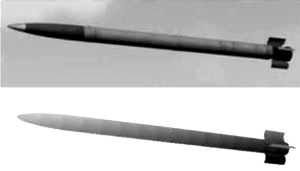Estimation of radar scattering characteristics of artillery shells in meter, decimeter and centimeter wavelength ranges
DOI:
https://doi.org/10.3103/S0735272719070033Keywords:
artillery shell, mathematic modeling, model electromagnetic response, secondary radiationAbstract
It is researched the characteristics of radar secondary radiation of artillery shells of different types which are obtained by mathematic modeling. There are described in brief the electrodynamic methods developed by the paper authors allowing to model electromagnetic responses of air objects of complicated shape and different electrical dimensions. In case of a length and diameter of the shells are comparative to probing wave length (they have resonance dimensions) we use for calculation the method based on solution of integral equation of magnetic field. For simulation of the characteristics of secondary radiation of the shells with electrically great dimensions we use asymptotic high frequency method. Developed methods are verified by means of comparison of calculation data for modeled objects with the other authors’ numerous results and also with physical experiment data. There are shown the characteristics of secondary radiation of the shells in meter, decimeter and centimeter wavelength range. There are discussed main regularities of their secondary radiation in case two orthogonal polarizations and different time-frequency parameters of radar probing signal.References
- KRUPNIKOV, A. “Counter-battery radar stations of main foreign countries,” Zarubezhnoye Voyennoye Obozreniye, n.12, p.32, 2010.
- Introduction to AN/TPQ-36/37 Radar Upgrade. URI: http://www.intersoft-electronics.com/Downloads/Radar%20Upgrades/TPQ36%20Radar%20Upgrade%20Presentation.pdf.
- AN/TPQ-53 Q-53 Counterfire target acquisition radar system. URI: https://www.armyrecognition.com/united_states_us_army_artillery_vehicles_system_uk/an/tpq-53_q-53_counterfire_target_acquisition_radar_system_technical_data_sheet_specifications.html.
- “New Ukrainian Counter-Battery Radar Successfully Completes Field Trials,” Defence Blog. Online Military Magazine. URI: https://defence-blog.com/army/new-ukrainian-counter-battery-radar-successfully-completes-field-trials.html.
- Russian Weapon. Modernized Artillery Radiolocation Complex for Investigation and Servicing of Ground Artillery ARK-1M “Rys”. URI: http://armsdata.net/russia/0120.html.
- ERGÜL, Ö.; GÜREL, L. “Linear-linear basis functions for MLFMA solutions of magnetic-field and combined-field integral equations,” IEEE Trans. Antennas Propag., v.55, n.4, p.1103, Apr. 2007. DOI: https://doi.org/10.1109/TAP.2007.893393.
- GIBSON, W.C. The Method of Moments in Electromagnetics, 2nd ed. Boca–Raton–London–New York: Chapman & Hall/CRC, 2014. URI: https://www.crcpress.com/The-Method-of-Moments-in-Electromagnetics/Gibson/p/book/9781482235791.
- YLÄ-OIJALA, P.; TASKINEN, M.; JÄRVENPÄÄ, S. “Analysis of surface integral equations in electromagnetic scattering and radiation problems,” Engineering Analysis with Boundary Elements, v.32, n.3, p.196, 2008. DOI: https://doi.org/10.1016/j.enganabound.2007.08.004.
- YAN, Su; JIN, Jian-Ming; NIE, Zaiping. “Improving the accuracy of the second-kind Fredholm integral equations by using the Buffa-Christiansen functions,” IEEE Trans. Antennas Propag., v.59, n.4, p.1299, Apr. 2011. DOI: https://doi.org/10.1109/TAP.2011.2109364.
- UBEDA, E.; TAMAYO, J.M.; RIUS, J.M. “Taylor-orthogonal basis functions for the discretization in method of moments of second kind integral equations in the scattering analysis of perfectly conducting or dielectric objects,” PIER, v.119, p.85, 2011. DOI: http://dx.doi.org/10.2528/PIER11051715.
- CHENG, J.; ADAMS, R.J.; YOUNG, J.C.; KHAYAT, M.A. “Augmented EFIE with normally constrained magnetic field and static charge extraction,” IEEE Trans. Antennas Propag., v.63, n.11, p.4952, Nov. 2015. DOI: https://doi.org/10.1109/TAP.2015.2478936.
- SUKHAREVSKY, O.I.; ZALEVSKY, G.S.; VASILETS, V.A. “Modeling of ultrawideband (UWB) impulse scattering by aerial and subsurface resonant objects based on integral equation solving,” in: Taylor, J. D. (ed.), Advanced Ultrawideband Radar: Signals, Targets, and Applications. Boca Raton London New York: CRC Press Taylor & Francis Group, 2016, Ch.5, p.195-235. DOI: https://doi.org/10.1201/9781315374130.
- LAPPALAINEN, J.; YLÄ-OIJALA, P.; TZAROUCHIS, D.C.; SIHVOLA, A. “Resonances of characteristic modes for perfectly conducting objects,” IEEE Trans. Antennas Propag., v.65, n.10, p.5332, Oct. 2017. DOI: https://doi.org/10.1109/TAP.2017.2741063.
- SURGAY, M.V.; ZALEVSKY, G.S.; VASILETS, V.O.; SUKHAREVSKY, O.I. “Estimation of the radar visibility level of rocket of the multiple rocket launcher ‘Grad’ in different wave bands,” Zbirnyk Naukovykh Prats KhUPS, n.2, p.142, 2017. URI: http://nbuv.gov.ua/UJRN/ZKhUPS_2017_2_30.
- SURGAY, M.V. “Mathematic simulation of secondary radiation characteristics of the shell OF-25 for self-propelled gun 2C3 ‘Akatsiya’ in various wave bands,” Science and Technologies of Air Forces of Armed Forces of Ukraine, n.3, p.135, 2018. DOI: http://doi.org/10.30748/nitps.2018.32.18.
- LIU, Y.; GUO, X.-Y.; ZHOU, H.-J. “A memory saving augmented EFIE with modified basis functions for low-frequency problems,” IEEE Trans. Antennas Propag., v.66, n.3, p.1359, Mar. 2018. DOI: https://doi.org/10.1109/TAP.2018.2789983.
- MACKIE-MASON, B.; GREENWOOD, A.; PENG, Z. “Adaptive and parallel surface integral equation solvers for very large-scale electromagnetic modeling and simulation,” PIER, v.154, p.143, 2015. DOI: http://dx.doi.org/10.2528/PIER15113001.
- LIU, Y.; YÜCEL, A.C.; BAGCI, H.; GILBERT, A.C.; MICHIELSSEN, E. “A wavelet-enhanced PWTD-accelerated time-domain integral equation solver for analysis of transient scattering from electrically large conducting objects,” IEEE Trans. Antennas Propag., v.66, n.5, p.2458, May 2018. DOI: https://doi.org/10.1109/TAP.2018.2809555.
- TASIC, M.S.; KOLUNDZIJA, B.M. “Method of moment weighted domain decomposition method for scattering from large platforms,” IEEE Trans. Antennas Propag., v.66, n.7, p.3577, July 2018. DOI: https://doi.org/10.1109/TAP.2018.2829821.
- KALFA, M.; ERGÜL, Ö.; ERTÜRK, V.B. “Error control of multiple-precision MLFMA,” IEEE Trans. Antennas Propag., v.66, n.10, p.5651, Oct. 2018. DOI: https://doi.org/10.1109/TAP.2018.2854405.
- GORSHKOV, S.A.; LESHCHENKO, S.P.; ORLENKO, V.M.; SEDYSHEV, S.Yu.; SHIRMAN, Ya.D. (eds.), Computer Simulation of Aerial Target Radar Scattering, Recognition, Detection, and Tracking. Norwood, M.A.: Artech House, 2002. ISBN-10: 1580531717, ISBN-13: 978-1580531719.
- BARABASH, Yu.L.; BRATCHENKO, G.D.; GONCHARUK, A.A. “Mathematic model and results of simulation of signal recognition and detection of the guns in radars of investigation of fire positions,” Visnyk Natsional’nogo Universitetu im. T. Shevchenko, n.10, p.6, 2005.
- SUKHAREVSKY, O.I. (ed.), Electromagnetic Wave Scattering by Aerial and Ground Radar Objects. Boca Raton: SRC Press, 2015. DOI: https://doi.org/10.1201/9781315214511.
- SUKHAREVSKY, O.I.; VASILETS, V.A.; NECHITAYLO, S.V. Handbook of Scattering Characterisitcs of Air and Ground Radiolocation Objects [in Ukrainian]. Kharkiv: KhUPS, 2019. ISBN 978-966-468-087-2.
- BARRETT, T.W. “Ultrawideband (UWB) time-frequency signal processing,” in: Taylor, J. D. (ed.). Advanced Ultrawideband Radar: Signals, Targets, and Applications. Boca Raton London New York: CRC Press, 2016, Ch. 4, p.105-194. DOI: https://doi.org/10.1201/9781315374130.

Downloads
Published
2019-07-25
Issue
Section
Research Articles

